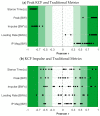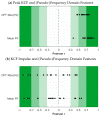Monitoring Knee Contact Force with Force-Sensing Insoles
- PMID: 37430813
- PMCID: PMC10223214
- DOI: 10.3390/s23104900
Monitoring Knee Contact Force with Force-Sensing Insoles
Abstract
Numerous applications exist for monitoring knee contact force (KCF) throughout activities of daily living. However, the ability to estimate these forces is restricted to a laboratory setting. The purposes of this study are to develop KCF metric estimation models and explore the feasibility of monitoring KCF metrics via surrogate measures derived from force-sensing insole data. Nine healthy subjects (3F, age 27 ± 5 years, mass 74.8 ± 11.8 kg, height 1.7 ± 0.08 m) walked at multiple speeds (0.8-1.6 m/s) on an instrumented treadmill. Thirteen insole force features were calculated as potential predictors of peak KCF and KCF impulse per step, estimated with musculoskeletal modeling. The error was calculated with median symmetric accuracy. Pearson product-moment correlation coefficients defined the relationship between variables. Models develop per-limb demonstrated lower prediction error than those developed per-subject (KCF impulse: 2.2% vs 3.4%; peak KCF: 3.50% vs. 6.5%, respectively). Many insole features are moderately to strongly associated with peak KCF, but not KCF impulse across the group. We present methods to directly estimate and monitor changes in KCF using instrumented insoles. Our results carry promising implications for internal tissue loads monitoring outside of a laboratory with wearable sensors.
Keywords: knee contact force; musculoskeletal modeling; statistical modeling; tissue loading; wearable.
Conflict of interest statement
The authors declare no conflict of interest.
Figures






Similar articles
-
Relationship between knee joint contact forces and external knee joint moments in patients with medial knee osteoarthritis: effects of gait modifications.Osteoarthritis Cartilage. 2018 Sep;26(9):1203-1214. doi: 10.1016/j.joca.2018.04.011. Epub 2018 Apr 30. Osteoarthritis Cartilage. 2018. PMID: 29715509
-
The effects of knee pain on knee contact force and external knee adduction moment in patients with knee osteoarthritis.J Biomech. 2021 Jun 23;123:110538. doi: 10.1016/j.jbiomech.2021.110538. Epub 2021 May 18. J Biomech. 2021. PMID: 34034013
-
Using load sensing insoles to identify knee kinetic asymmetries during landing in patients with an Anterior Cruciate Ligament reconstruction.Clin Biomech (Bristol). 2023 Apr;104:105941. doi: 10.1016/j.clinbiomech.2023.105941. Epub 2023 Mar 15. Clin Biomech (Bristol). 2023. PMID: 36958202
-
Effect of foot progression angle adjustment on the knee adduction moment and knee joint contact force in runners with and without knee osteoarthritis.Gait Posture. 2018 Mar;61:34-39. doi: 10.1016/j.gaitpost.2017.12.029. Epub 2017 Dec 30. Gait Posture. 2018. PMID: 29304509
-
A Systematic Review of the Associations Between Inverse Dynamics and Musculoskeletal Modeling to Investigate Joint Loading in a Clinical Environment.Front Bioeng Biotechnol. 2020 Dec 7;8:603907. doi: 10.3389/fbioe.2020.603907. eCollection 2020. Front Bioeng Biotechnol. 2020. PMID: 33365306 Free PMC article.
References
MeSH terms
Grants and funding
LinkOut - more resources
Full Text Sources

